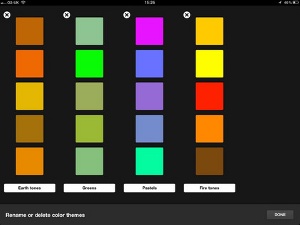Hands-on with Adobe Color Lava for iPad
With CS5.5 Adobe has plans for integrating the iPad into your workflow. Steve Caplin takes a look.
Using Photoshop with a mouse, or even with a graphics tablet, removes the artist from the process by having to use a separate tool to draw with: how much better it would be if we could just paint straight onto a multi-touch screen, such as the Apple iPad.
That, in essence, is Adobe's reason for creating the possibility of controlling and linking to Photoshop through a tablet device.
To demonstrate the possibilities in this convergence of two technologies, Adobe is releasing three iPad apps that give a taste of what may come, showing off some of the potential of the new, extensible architecture of Photoshop CS5.5. These are not perfect, finished apps, but serve to show off the possibilities.
Adobe Color Lava
All designers need to create groups of matching colours, whether they're creating a brochure, a website or an abstract painting.
Color Lava aids this process through an iPad app that allows users to blend colours together by smudging them into each other. In essence, this is very similar to the colour mixer palette that used to exist in Photoshop before it was pulled due to patent infringements.
Users start with six basic colours, and selecting any one of them allows us to paint it onto the canvas area.
Daily design news, reviews, how-tos and more, as picked by the editors.
We can then smear and drag the colours, and as we drag the colour directly beneath our finger is shown in one of the five colour swatches down the right hand side of the screen. At any time, we can switch to a different colour swatch to store a separate colour in it.

We can create an almost unlimited number of these five-set swatch groups, naming each one as we see fit; the canvas we used to generate these swatches is stored along with it. And here's the best part: tapping any of the colours transmits the colour directly to Photoshop, where it becomes the foreground colour.
As well as starting with a blank canvas, we can opt to load a photo from the iPad's album and sample colours from it - and we can also smear and smudge the colours together in the image.
This smudging ability is well thought-out and responsive, and it's a pity the same tool didn't make it into Eazel, where it could have been put to good use.
The concept is a good one, but it falls down in that we only have an HSB (Hue, Saturation and Brightness) model to choose the initial colours. For those used to RGB or even Web colours, this is an irritation; for print designers, the lack of a CMYK model is more than frustrating.
Steve has also been taking a look at Adobe Nav and Eazel for TechRadar. Follow the link for his full impressions: Hands on: Adobe Photoshop CS5 iPad apps review

The Creative Bloq team is made up of a group of art and design enthusiasts, and has changed and evolved since Creative Bloq began back in 2012. The current website team consists of eight full-time members of staff: Editor Georgia Coggan, Deputy Editor Rosie Hilder, Ecommerce Editor Beren Neale, Senior News Editor Daniel Piper, Editor, Digital Art and 3D Ian Dean, Tech Reviews Editor Erlingur Einarsson, Ecommerce Writer Beth Nicholls and Staff Writer Natalie Fear, as well as a roster of freelancers from around the world. The ImagineFX magazine team also pitch in, ensuring that content from leading digital art publication ImagineFX is represented on Creative Bloq.
